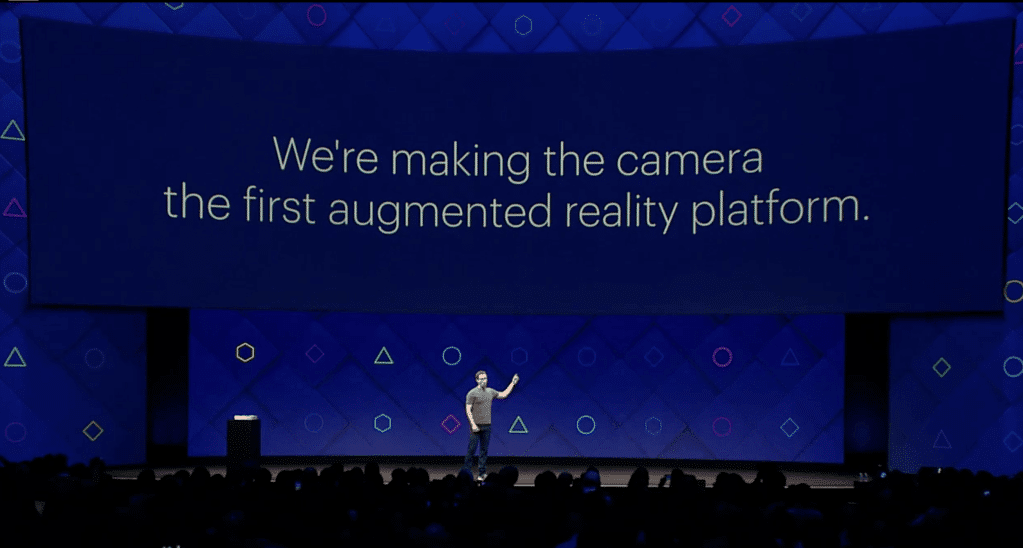
As we’ve mentioned, mobile AR will dominate before smart-glasses do. It’s clear from today’s installed base of devices (2.6 billion smartphones) that mobile will be the venue for AR innovation and opportunity in the near term.
Today’s tech giants increasingly show signs of agreeing with that principle — most notably Snapchat and Facebook. Though their early attempts aren’t “true AR” — at least by purist standards — they’re doing AR a favor by seeding demand in early days.
We first saw this with Pokemon Go and Snapchat 3D stickers, which just expanded into “real world lenses.” That was followed this week by the ultimate retort from Facebook: its AR-heavy F8 conference.
AR peppered the script of the event’s opening keynote. More broadly, AR goes hand in hand with Facebook’s (non-original) theme of the event: the smartphone camera is its new strategic foundation.
This comes down to the underlying fact that the smartphone has a viewfinder, a lens and lots of graphical processing power. Therefore it’s a natural and, again, ubiquitous platform on which to build AR.

Network Effects
At the center of it all is Facebook’s new Camera Effects Platform. This is a set of tools for developers (AR Studio) and non-developers (Frame Studio) to create AR graphics. It includes stickers, geofilters and other clever integrations people will create.
This importantly differs from Snapchat’s closed approach in that an open platform can yield a much greater library of graphics and apps. There will be thousands of stickers and filters, instead of the tens that Snapchat offers.
Facebook will end up with the standard fare of selfie masks, but also new creations from developers. For example, applications that let you leave notes for friends in physical places, or tag buildings with virtual paint (cheaper and cleaner).
And by virtue of Facebook’s deep pockets, the AR itself is improving. Computer vision and simultaneous location and mapping (SLAM) render graphics that interact with the contours of the world in dimensionally accurate ways (a.k.a “true AR”).

Business Model Innovation
Eventually, brands will also get creative with these tools in the spirit of the “native advertising” that’s become Facebook’s bread and butter. Nike for example can offer selfie-adorning AR graphics for fitness milestones people want to share.
For local advertising, think: sharing restaurant reviews or menu recommendations. The “ad inventory” for local businesses to make themselves visible thus extends to their physical spaces, viewable in AR.
Snapchat already does this with Geofilters but Facebook’s open approach will let developers concoct even greater AR tools for local merchants. For now Facebook isn’t offering it to advertisers but you can bet that’s coming.
Elsewhere in AR, Apple is rumored to enter the space with the next iPhone. And Microsoft is perhaps farthest ahead in positioning and technological chops with HoloLens and the Windows MR platform that runs it (though not ‘mobile’).
Back to Facebook, the real innovation won’t just happen on technical levels: The AR-heavy approach to was plucked wholesale from Snapchat. Rather, it’s a business model innovation in the open platform approach, and scale.
The latter is critical and it’s where Facebook shines. Put another way, AR is about the real world which is a big place. Facebook showed this week that it knows it will take an army of outside developers to fill such a large canvas.
For a deeper dive on AR & VR insights, see ARtillry’s new intelligence subscription, and sign up for the free ARtillry Weekly newsletter.
Disclosure: ARtillry has no financial stake in the companies mentioned in this post, nor received payment for its production. Disclosure and ethics policy can be seen here.
Header image credit: Facebook
